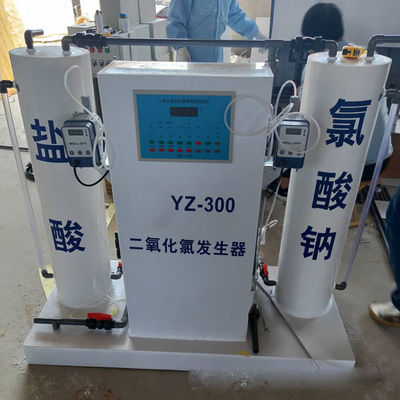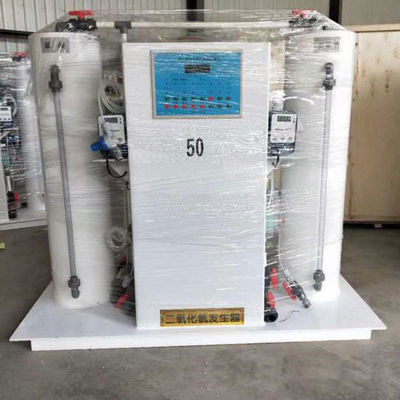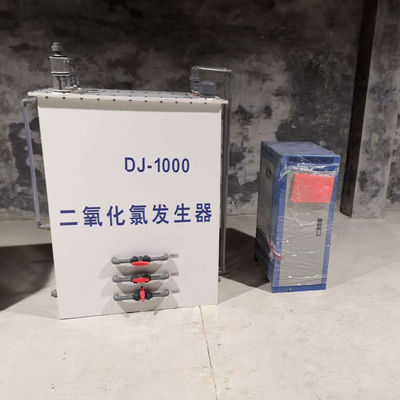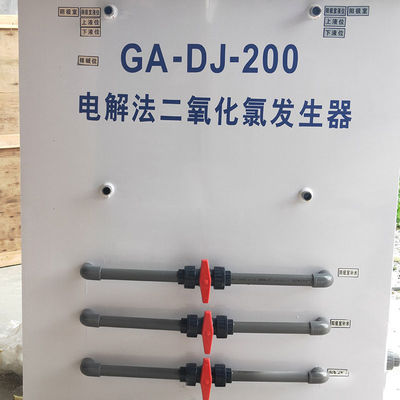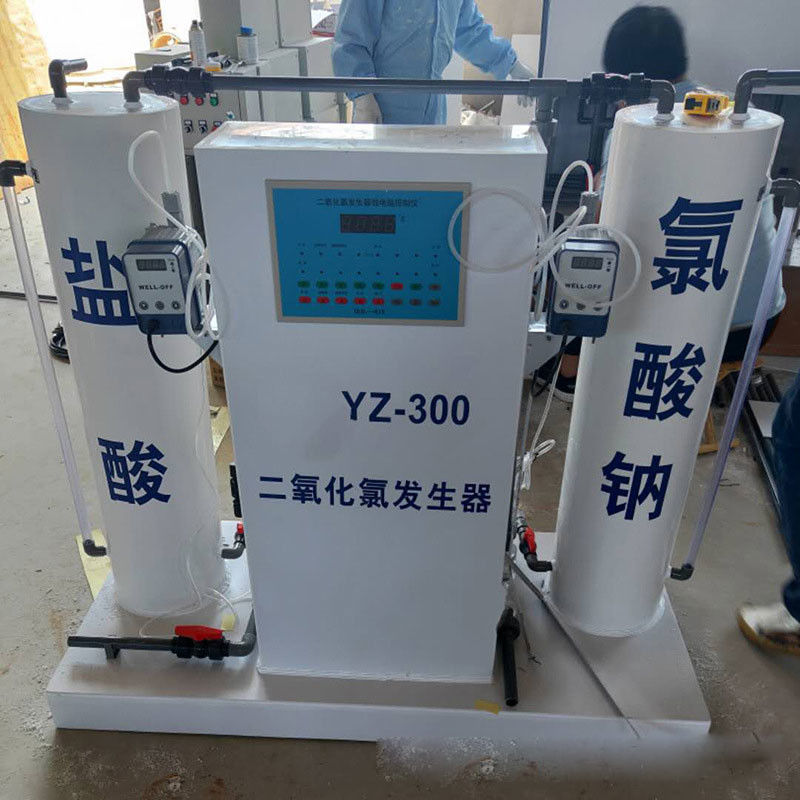Hospital Water Disinfection Equipment , Chlorine Dioxide Water Treatment System
Product Details:
| Place of Origin: | China |
| Brand Name: | Fenigal/OEM |
| Certification: | CE/NSF etc. |
| Model Number: | ClO2 |
Payment & Shipping Terms:
| Minimum Order Quantity: | 1 Set |
|---|---|
| Price: | Negotiable |
| Packaging Details: | Standard Export Wood Crate/Carton or Naked wrapped by film |
| Delivery Time: | 15~30 days |
| Payment Terms: | T/T, Western Union, Paypal etc. |
| Supply Ability: | 200 set per month |
|
Detail Information |
|||
| Design: | Skid Mount | ClO2 Concentrations: | 0.2 To 2.5 Mg/L |
|---|---|---|---|
| Reagent 1: | Purogene (NaClO2 At 3.36%) | Reagent 2: | HCl 15% |
| Voltage: | 380V,415V,220V,can Be Customized | Application: | Disinfection |
| Highlight: | 380V Water Disinfection Equipment,ClO2 Water Disinfection Equipment,OEM chlorine dioxide water treatment system |
||
Product Description
Hospital integrated sewage treatment equipment Chlorine dioxide Laboratory electrolysis generator
Chlorine Dioxide dosing systems are a safe and efficient method of disinfecting your building’s water supply. Legionella and dangerous pathogens are destroyed by ClO2, protecting your patients when they need a safe drinking water supply most.
The benefits of Chlorine Dioxide generator include:
- >95% efficiency at generating ClO2, which is a requirement for healthcare under the HTM-04-01 regulations
- Submerged reactor technology (360° water jacket); an external vessel of water surrounds the inner ClO2 vessel, meaning safety is assured
- In-built standard safety features; high level safety cut-off and continuous monitoring of ClO2 and chlorite levels within the water system
- ClO2 gas vapour detector as standard, shuts down the system in the event of an activation
- Long generator lifespan of 10+ years, with a total lifecycle cost of over 10 years
- No need to store concentrated ClO2 on-site; ClO2 is generated at the point of injection into the water stream
ClO2 is an effective and powerful disinfectant. It is capable of inactivating bacteria and viruses, spores and moulds. Inactivation of Giardia is possible with low doses and Cryptosporidium Parvuum with a CT value of 78.
Table 1 1
| Bacterial Reduction Using Chlorine Dioxide | |||
| Micro-organisms | ppm of ClO2 | Contact Time (s) |
Inactivation in % |
| Staphylococcus aureus | 1 | 60 | 99.999 |
| Eschericia Coli | 0.15 | 300 | 99.9 |
| Eschericia Coli | 0.25 | 60 | >99.999 |
| Streptococcus | 1 | 15 | >99.999 |
| Lactobacillus Brevis | 0.15 | 300 | 99.9 |
| Lactobacillus Brevis | 1 | 300 | >99.999 |
| Pseudomonas aeruginosa | 1 | 60 | >99.999 |
| Fungicidal Activity of Chlorine Dioxide | |||
| Micro-organisms | ppm of ClO2 | Contact Time (min) |
Inactivation in % |
| Saccharomyces diastaticus (yeast) | 0.15 | 10 | 99.9 |
| Saccharomyces diastaticus (yeast) | 1 | 1 | >99.999 |
| Saccharomyces diastaticus (yeast) | 0.5 | 10 | >99.999 |
| Saccharomyces diastaticus (yeast) | 1 | 1 | >99.999 |
| Penicillum expansum (mould) | 0.5 | 60 | 99.99 |
| Penicillum expansum (mould) | 2 | 20 | 99.999 |
| Pediococcus Damnosus (yeast) | 0.15 | 20 | 99.99 |
| Pediococcus Damnosus (yeast) | 0.3 | 5 | 99.99 |
| Pediococcus Damnosus (yeast) | 1 | 5 | 99.999 |
| Pectinatus cervisiiphilus (yeast) | 0.1 | 5 | 99.9 |
ClO2 Advantages Over Chlorine
Higher yield & greater cost efficiencies - Chlorine Dioxide has a higher oxidation capacity, and a lower oxidation strength than most species of chlorine, making it at least 2.6 times more powerful per ppm according to WHO CT values.
No carcinogenic by-products & no bad taste occurrences in water - Chlorine Dioxide acts only by oxidation and does not combine with organic compounds to form environmentally hazardous by-products such as Trihalomethane and other chlorinated organic compounds that have been listed as potentially carcinogenic.
Less corrosive - Chlorine Dioxide has a lower oxidation potential and does not hydrolyse to form an acid, and therefore is less corrosive.
Works over a wide pH - The effectiveness of chlorine is very pH dependent, and is almost ineffective above pH8. Chlorine Dioxide is effective at all pH’s below 12.
Effective against complex organisms - Chlorine Dioxide has been found to be effective against complex organisms such as cysts and protozoa including Cryptosporidium, Giardia and amoeba. Chlorine is not.
Destroys biofilm completely at source by penetrating polysaccharide layers to destroy pseudomonas and other base bacteria within the biofilm. Chlorine does not.
The oxidising properties and the radical nature of Chlorine Dioxide make it an excellent virucidal and bactericidal agent in a large pH range.
How ClO2 kills pathogen?
In alkaline media the permeability of living cell walls to gaseous chlorine dioxide radicals seems to be increased allowing an easier access to vital molecules. The reaction of chlorine dioxide with vital amino acids is one of the dominant processes of its action on bacteria and viruses.
![]()
Compounds within the cells and on the surface of cell membranes that contain oxidisable material react with chlorine dioxide, causing cell metabolism to be disrupted. Chlorine dioxide also reacts directly with disulphide bonds in the amino acids and the RNA in the cell. Unlike non-oxidizing disinfectants, chlorine dioxide kills microorganisms even when they are inactive. The oxidative load placed on the cells by the action of chlorine dioxide mean that most microorganisms are unable to build up resistance to chlorine dioxide.
In practical terms however, few bacteria live alone, and they are most often found in water and on surfaces in the form of a "biofilm" which is a close association of many millions of bacteria. Many biocides have particular problems in penetrating this biofilm, due to the polysaccharide "glue" that is secreted by bacteria such as Pseudomonas to hold the biofilm together. Unlike most biocides, chlorine dioxide can effectively penetrate the polysaccharide layer of biofilm without being used up in reacting with the inert sugars. This allows the ClO2 to act on the bacteria themselves, destroying the biofilm.
![]()
Chlorine dioxide is one of a number of disinfectants that are effective against Giardia Lambia and Cryptosporidium oocysts, which cause diseases such as cryptosporidiosis in public drinking water supplies. A number of public water works are now utilising chlorine dioxide generation systems alongside UV systems in order to provide complete protection from Cryptosporidium.
ClO2 Advantages Over Other Oxidising Biocides
When compared with other oxidising biocides, Chlorine Dioxide has a significantly lower oxidation strength – this means that it reacts with fewer compounds, such as organic compounds and ammonia, yet is strong enough to attack the disulphide bonds found in the membranes of bacteria and other biological material.
![]()
This process of “selective oxidation” allows the Chlorine Dioxide biocide to be targeted where it is needed most, disinfecting areas quickly and at lower dose rates, leading to greater cost efficiencies.



